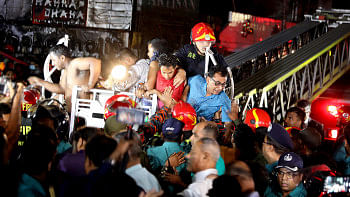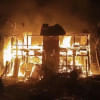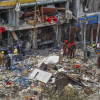Can we rethink the city we want?

Following the tragic fire at Dhaka's Bailey Road last week, fingers are being pointed at restaurant owners and regulators. Raids are being conducted to shut down restaurants that don't have proper safety measures. This is typical of any notable accident in Bangladesh. Immediate reactions include tough rhetoric and strong enforcement of existing regulations, until the next terrible thing happens and everyone moves on.
But have we stopped to wonder why this tragedy had to happen? The easy answer is it happened because too many restaurants, businesses, and buildings in general in Dhaka are cavalier about safety. But then, why are there so many restaurants in Dhaka? Why do these restaurants feel compelled to skirt around safety measures? And why do all of these restaurants have to be stuffed into skyscrapers that far too often become concrete coffins and furnaces?
Many of Dhaka's streets seem to have been taken over by restaurants during the past decade or so. Buildings like Green Cozy Cottage Shopping Mall in Bailey Road where the fire took place, which are predominantly used for restaurants and nothing else, are beyond common.
Yet, it's not as if we have "too many" restaurants. These are commercial, for-profit entities who won't exist unless it makes financial sense for them. Attempt to visit a well-regarded restaurant in Dhaka on a Thursday night or any holiday, and it will be clear that the kitchens are struggling to keep up with orders, and they are often unable to seat every patron.
However, there is something to be said about the rate at which restaurants have increased. The study titled "Hotel-Restaurant Survey 2021", published by the Bangladesh Bureau of Statistics (BBS), says that the number of restaurants, hotels, and tea stalls across the country rose from over 275,000 in 2009-10 to over 436,000 in 2021. This data quantifies the perception that, seemingly with every blink, a bunch of new restaurants open up wherever we look.
This rapid expansion of the restaurant sector has led to the cutting of many vital corners when it comes to safety. Mobile courts and RAJUK officials may be cracking down on specific violations, but the reality is that this drive will wane. Eventually, the biriyani places they shut down will be replaced by new ones who may cut corners on some other safety measure to keep their competitive edge. This is bound to happen because the public's need to go and have a meal outside will not subside any time soon. The culture of grabbing a meal outside once in a while is an inseparable part of modern urban life.
Dhaka's story is much the same, but those who live in this city will point to another fact of life here that drives people to go to restaurants more so than in other cities. In Dhaka, there isn't much to do other than to go out and eat. Cultural events do take place, but there aren't nearly enough of them. The next natural step in this discourse leads to an old culprit—the lack of open spaces.
Of course, the talk of open space leads one to parks and plazas, of which there are few in this city. While they do provide alternatives for recreation, there isn't much reason to believe restaurant crowds will be diverted to parks as soon as they start existing. Where will they eat?
However, we can expand the idea of open spaces to include walking-friendly streets and human-scale construction where the focus is to connect streetside establishments like restaurants and shops with the streets that they are situated on. Think eateries where the seating spills out onto the streets, groceries where you can shop standing on the footpath, window shopping that is possible without entering a shopping mall, and streets with wide pavements where building height is restricted so people don't have to crane their necks to see what's on offer.
Other than serving the purposes that a street is supposed to, pedestrian friendly streets can become destinations themselves. Like a park or a plaza, people visit these areas because they are appealing options for recreation. Suddenly, Dhaka's long-standing problem with hawkers becomes a blessing, and a chance to develop the prevalence of streetside shopping that already exists in the city and turn it into a cultural feature.
All of this is possible by foregoing the idea of uncontrolled density, and letting go of the greed that drives landowners to make use of every square inch of floor space available to them. What businesses in these areas might lose by not building high-rises can be offset with the number of people who show up to these areas with no preconceived plans of spending money, but do so anyway because the environment is pleasant and the options are present. Another way to do this would be to encourage mixed use buildings, where the ground floor is given up for commercial activity while the upper floors house apartments or offices.
If these ideas sound familiar, that's because versions of these practices are common in our city already. Mixed use buildings are easy to spot in many neighbourhoods, and as for streetside commercial activity, it's everywhere. Without incorporating proper zoning regulations and walkability, however, these features feel like a blight on the face of this city, which is possibly how many of us perceive them anyway.
The ideas of "New Urbanism"—an urban design movement—promote cities that prioritise walkable neighbourhoods, human-scale design, and open public spaces. It is a relatively new movement that denounces the idea of car centric development, and buildings that separate their occupants from their surroundings. It's an ambitious way of looking at modern cities that Dhaka, as the capital of a still-developing Bangladesh, may not be able to afford to buy into completely.
But here's the thing, the way Dhaka has developed naturally over time has many new urbanist elements ingrained in it. In many old neighbourhoods, mixed use buildings and necessities like groceries and schools do exist within walkable distances. Strong community bonds persevere even today in some places, where the moholla is still a strong social unit.
Yet, modern day development in Dhaka has not looked to build on these characteristics. Instead, we have distanced from them. We have grown obsessed with building upwards, and maximising usage out of every parcel of land. Right now, the most profitable usage seems to be to rent floor space out to restaurants, who will take every opportunity to circumvent safety regulations that are too expensive or cumbersome. The authorities may be able to regulate this, and bring some discipline back, but it does not address the underlying issue that has led to this unnatural status quo.
Wouldn't it be nice if Dhaka residents had a few more options for recreation that didn't involve eating? Safety can be addressed head on, or the underlying causes of the lack of safety can be addressed, resulting in the adoption of some drastic changes that have a long-lasting positive effect. Right now, Dhaka is being held together with pins and bandages. Our city desperately needs some long-term cures.
Azmin Azran is a journalist at The Daily Star.
Views expressed in this article are the author's own.
Follow The Daily Star Opinion on Facebook for the latest opinions, commentaries and analyses by experts and professionals. To contribute your article or letter to The Daily Star Opinion, see our guidelines for submission.

 For all latest news, follow The Daily Star's Google News channel.
For all latest news, follow The Daily Star's Google News channel. 












Comments